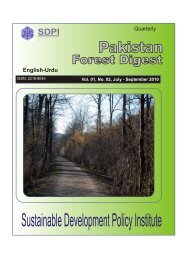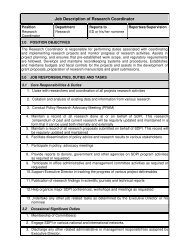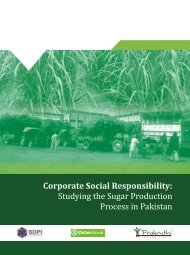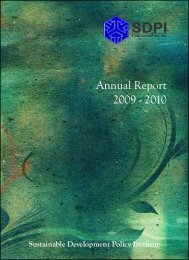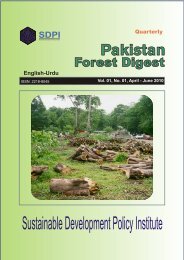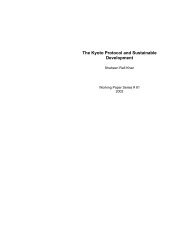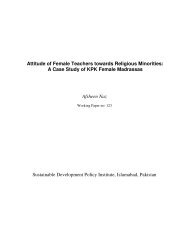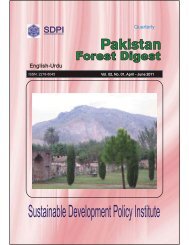Past, Present and Future 1Muhammad Asif Wazir Policy Brief # 35
Past, Present and Future 1Muhammad Asif Wazir Policy Brief # 35
Past, Present and Future 1Muhammad Asif Wazir Policy Brief # 35
You also want an ePaper? Increase the reach of your titles
YUMPU automatically turns print PDFs into web optimized ePapers that Google loves.
Population Dynamics in Pakistan:<strong>Past</strong>, <strong>Present</strong> <strong>and</strong> <strong>Future</strong>1 Muhammad <strong>Asif</strong> <strong>Wazir</strong><strong>Policy</strong> <strong>Brief</strong> # <strong>35</strong>1 Muhammad <strong>Asif</strong> <strong>Wazir</strong>, PhD, Senior Researcher, Population Council (Pakistan office), E-mail:mwazir@popcouncil.org
All rights reserved. No part of this paper may be reproduced or transmitted in any form or by anymeans, electronic or mechanical, including photocopying, recording or information storage <strong>and</strong>retrieval system, without prior written permission of the publisher.A publication of the Sustainable Development <strong>Policy</strong> Institute (SDPI).The opinions expressed in the papers are solely those of the authors, <strong>and</strong> publishing them doesnot in any way constitute an endorsement of the opinion by SDPI.Sustainable Development <strong>Policy</strong> Institute is an independent, non-profit research institute onsustainable development.© 2013 by the Sustainable Development <strong>Policy</strong> InstituteEdited by: Salim KhiljiFirst Edition: August 2013Mailing Address: PO Box 2342, Islamabad, Pakistan.Telephone + (92-51) 2278134, 2278136, 2277146, 2270674-76Fax + (92-51) 22781<strong>35</strong>, URL: www.sdpi.org
Table of ContentsIntroduction ................................................................................................................................ 1<strong>Future</strong> Population of Pakistan .................................................................................................... 2Conclusion <strong>and</strong> <strong>Policy</strong> Implications ............................................................................................ 5References ................................................................................................................................ 6
IntroductionPakistan is one of the largest <strong>and</strong> fastest growing countries in the world. In 2010, it ranked 6thmost populous country <strong>and</strong> will st<strong>and</strong> at 4th in 2050. Pakistan’s rapid population growth, duringthe second half of the 20th century, can largely be explained by the conventional demographictransition theory i.e. rapid decline in mortality rate combined with a gradual decline in fertilityrate. Consequently, the country’s population has been growing untamable since independencein 1947 i.e. from 34 million reported in the first census in 1951 to 132 million in 1998 <strong>and</strong>estimated at 183 million inhabitants in 2012.Since the 1950, Pakistan has experienced a significant population growth rate ranging betweentwo to four per cent per annum. During the period of 1950-1985, the country’s population hadgrown at the average rate of 3 per cent per annum. However, it declined to an average of 2.6per cent per annum during the period 1986-2000. In 2010, the population growth rate inPakistan was 1.8 per cent. Pakistan is likely to continue experiencing population growth in thenear <strong>and</strong> distant future at least until 2050 <strong>and</strong> more so than any other world region except sub-Saharan Africa. Thus, rapid population growth in Pakistan hindered the socio-economicdevelopment in the past <strong>and</strong> it will have to adopt the development model capable to absorb theincrease. If country fails, it will be confronted with several major risks, including politicalinstability <strong>and</strong> poverty trap.Pakistan has remarkably young age structure. In 2010, nearly two-thirds of the Pakistanipopulation was less than 30 years old with a median age of 21.7 years. The young age structurehas been persistent in Pakistan for the last five decades. The share of school age population(0-14 years old) was on the average 40 per cent from 1950s to 2000 <strong>and</strong> estimated at 36 percent (61 million) in 2010. The share of working-age population (15-64 years old) has beengrowing from 54 per cent in the 1950s to 61 per cent in 2010 (See table 1). Currently, the SouthAsian region along with Sub-Saharan Africa is the only region in the world with a young agestructure <strong>and</strong> significant population growth. Within South Asia, Pakistan st<strong>and</strong>s out with thehighest population growth rate <strong>and</strong> very young age structure.The fertility transition did not keep pace with the mortality decline in the past. In Pakistan, it wasexpected to start in the 1970s as a response to mortality transition. However, due to politicalinstability, low socio-economic development <strong>and</strong> ineffective population policies, the targets forreducing fertility were not accomplished, even until recently. Thus, fertility level in the decadesof 1970s <strong>and</strong> 1980s in Pakistan had remained exceptionally high <strong>and</strong> fluctuating between six<strong>and</strong> seven children per women. It is a well accepted fact that fertility decline in Pakistan startedonly in the late 1980s <strong>and</strong> later gained momentum in the 1990s.Several factors contributed significantly to the fertility decline during the last decade of 20thCentury in Pakistan such as overall socio-economic development, increased literacy <strong>and</strong>educational attainment particularly for female, <strong>and</strong> strengthening of family planningprogrammes. However, Pakistan had the highest fertility rates in 2006 among South Asiancountries <strong>and</strong> most of the nations across the globe, except for Sub-Saharan Africa. Pakistan stillhas very high fertility rate i.e. 4.1 children per women. It is worth mentioning here that female1
education has a significant effect on fertility. Women having higher education have a fewerchildren as compared to women with less education <strong>and</strong> so is the case of Pakistan. Women withtertiary education have already attained below replacement level fertility 2 .The mortality transition in Pakistan started in the 1950s. Several studies show that the country’smortality improved quite significantly during the first two decades following independence. Lifeexpectancy at birth for both sexes has improved over the last five decades from 41.2 years in1950-55 to 64.6 years in 2005-2010. It is interesting to note here that life expectancy at birth inPakistan has improved linearly during the last six decades for male <strong>and</strong> female alike. Forinstance, during the last two decades, life expectancy at birth increased by 2.4 years for female<strong>and</strong> 2.2 years for male in Pakistan. The country has enacted substantial progress in infantmortality in recent decades. Infant Mortality Rate (IMR) has declined significantly following theindependence from 177 in 1950-55 to 71 deaths per 1000 live births in 2005-10.Pakistan has witnessed a high fertility in the past <strong>and</strong> population growth is beginning to level offas part of the demographic transition. Hence, Pakistan will experience a demographic bonus —a period of time when the share of working age population is prominent. In the next 30 to 40years, a majority of its population will be of working age with fewer younger <strong>and</strong> still few agedcitizens. In 2010, <strong>35</strong> per cent population of Pakistan aged below 15 years <strong>and</strong> 60 per cent of thepopulation was in the working-age (15-64). This rising share of the working age population couldbe translated into subsequent rise in the rate of economic growth if country can employ themeffectively. In this context, human capital will be central to the realization of this window ofopportunity for rapid economic growth.The educational achievement <strong>and</strong> literacy in Pakistan has not been impressive in the past. In arecent study, Goujon <strong>and</strong> <strong>Wazir</strong> (2011) have clearly shown that, the Pakistani educationalsystem has failed to provide the basic infrastructure, eliminate gender imbalances <strong>and</strong> thequality of education, which would be required to enjoy the full collateral benefits of demographicbonus such as high levels of economic growth <strong>and</strong> well-being.<strong>Future</strong> Population of PakistanThe future population is projected by using multi-state population projection methodology. Theprojection model is based on the base year population with defined educational categories <strong>and</strong>differentials of each demographic component of change i.e. fertility, mortality <strong>and</strong> migration. Theprojection results show that the population of Pakistan will be growing significantly in the nextfive decades i.e. from 174 million in 2010 to 281 million in 2060 though Pakistan will manage toachieve replacement level fertility by 20<strong>35</strong>-40. The substantial population growth in the future isdue to “population momentum” 3 . It may be mentioned that approximately half of the population2 Replacement level fertility is the level of fertility at which a population exactly replaces itself from onegeneration to the next. In numerical term, replacement level fertility assumes 2.1 children per women.3 Population momentum typically referred as, for countries that have undergone the middle phase of thedemographic transition, the population is growing significantly even though the fertility has fallen to orbelow the replacement level.2
growth in 2010 is due to population momentum, which will continue during the next fivedecades. This momentum would lead to further increase in the working-age (15-64) populationi.e. from 105 million in 2010 to 157 million in 2030 <strong>and</strong> 186 million in 2060 (See Table 1). Thus,Pakistan will need to adopt effective labor force policies to absorb the working age population.This large labor force, if well educated, skilled <strong>and</strong> sufficiently employed could be a key asset forthe socio-economic well-being.Owing to rapid fertility decline in the future, the proportion of population aged 65+ will acceleratefrom 7 million in 2010 to 42 million in 2060. The proportions of population aged 65+ are likely toincrease six times. This rapid population aging poses many challenges for policy makers <strong>and</strong> forinstitutional adaption, including the financing of pension <strong>and</strong> health care system for elderly. Asevident from figure 1, this large uneducated <strong>and</strong> unskilled young population along withsignificant proportion of aged population in the future would place extreme burden on economy,if not invested in education <strong>and</strong> health. Furthermore, the school age (below 14) population willbe stagnating during the next three decades (until 2030-<strong>35</strong>) i.e. approximately 61 million. Thisimplies that until 20<strong>35</strong>, more children will need to be enrolled in schools. More schools will beneeded <strong>and</strong> more teachers to be trained <strong>and</strong> hired, particularly in the rural areas. The share ofyoung population would however decline after 20<strong>35</strong> i.e. from 61 million in 20<strong>35</strong>-40 to 50 millionin 2055-60.Table 1: Population of Pakistan by broad groups from 1950 to 2060YearsPopulation (in millions)0-14 15-64 65+1950 15.1 (40%) 20.3 (54%) 2.1 (5.6%)1975 29.6 (43%) 36.0 (53%) 2.5 (4%)2010 61.3 (36%) 104.3 (61%) 6.4 (4%)2030 63.6 (28%) 154.6 (67%) 12.9 (6%)2060 54.2 (19%) 189.5 (68%) 34.7 (12%)Source: UN 2012 World Population Prospects,3
Figure 1: Share of Working-age Population by level of education in Pakistan for 2010 <strong>and</strong> 2060according to trend education <strong>and</strong> medium fertility scenarioSource: <strong>Wazir</strong>, A., et al. (2011)From figure 1, it is evident that <strong>35</strong> per cent of males <strong>and</strong> 65 per cent of females of working agepopulation had received no education in Pakistan in 2010. The projection results show thatpercentage of uneducated will decline to 15 per cent for male <strong>and</strong> 23 per cent for female in2060. The low proportion of secondary <strong>and</strong> tertiary educated male <strong>and</strong> female in the futurereflect the lack of investment in education in the recent years. The share of primary level of theworking age population in 2010 was 16 per cent for male <strong>and</strong> 12 per cent for female. Accordingto the trend, this would increase to 33 per cent for male <strong>and</strong> 38 per cent for female in 2060.Moreover, it is expected that the share of overall population (male <strong>and</strong> female) with secondary<strong>and</strong> tertiary education attainment would remain stable from 2010 to 2060. However, the share ofsecondary educated female in Pakistan would increase significantly in next 50 years i.e. from 15per cent to 21 per cent. Since the women enrolment in secondary <strong>and</strong> tertiary education hasincreased in the last decade, this would result in a doubling share of women in tertiary educationof working age population i.e. from 8 per cent in 2010 to 18 per cent in 2060.Figure 2: Population pyramid by age, sex <strong>and</strong> level of education of Pakistan in 2060Source: <strong>Wazir</strong>, A., et al. (2011)4
As expected, Pakistan will not be able to meet the Millennium Development Goals (MDGs)regarding education (goal 2 <strong>and</strong> 3), if it does not increase primary enrolment at a ratesignificantly higher than in the recent past. Figure 2 illustrates there would still be 23 per cent ofboys <strong>and</strong> 18 per cent of girls of the age group 5-9, who would not be enrolled in school by 2015.These targets would not be reached even by 2060. This calls for an effective educationalpolicies <strong>and</strong> further investment in education sector particularly in the rural areas. Moreover, thegender gap would not be eliminated at all levels of education in the next two decades <strong>and</strong> evenfar from being eliminated in 2060. However, the gender disparities would be eliminated at onelevel i.e. tertiary education. These projections show the tremendous improvement in favour ofgirls rather than boys due the fact that girls’ enrollment in Pakistani universities has beenamplified in the last decade.Conclusion <strong>and</strong> <strong>Policy</strong> ImplicationsIn Pakistan, the progress in education sector lags behind those found in most of other countrieswith similar level of development. Faced with the rapid population growth <strong>and</strong> consequently itslabour force, Pakistan will have to adopt a development model capable of absorbing theincrease. If the country fails, it will be confronted with two main risks: political instability, <strong>and</strong> apoverty trap. At present, Pakistan’s development is highly dependent on its capacity to educateits population so that 300 million Pakistanis in 2050 may live prosperous lives. Education hasmostly failed so far in terms of provision <strong>and</strong> quality because of the poor performance of thestate machinery. That’s why, Pakistan will fail to achieve the Millennium Development Goals interms of universal primary education for both sexes <strong>and</strong> other objectives on the national <strong>and</strong>international agenda. The scenarios that we looked at show that the speed of change inadvancing education has to be dramatically increased if the country would like to achieve allthese goals by mid-century. This is more urgent because the age structure will become more<strong>and</strong> more favourable <strong>and</strong> as of 2025, the large labour force, if well educated, could be a majorasset in the government h<strong>and</strong>s.The study points out two areas of particular concern: illiterate adult population <strong>and</strong> femaleeducation where investments will be highly needed.5
ReferencesGoujon, A. <strong>and</strong> <strong>Wazir</strong>. A., 2011. Human capital <strong>and</strong> population development: Pakistan <strong>and</strong> the “Cannon<strong>and</strong> Butter Dilemma.” Pages 157-182 in L. Hummel, J. Laurel, <strong>and</strong> L. Richard. (eds.) Underst<strong>and</strong>ingPakistan through Human <strong>and</strong> Environmental Systems. U.S. Army War College Center for StrategicLeadership: West Point, USA.<strong>Wazir</strong>, A., Goujon, A. <strong>and</strong> Lutz, W. 2011. Alternative Population <strong>and</strong> Education Trajectories for Pakistan.Interim report, IR-11-029, International Institute for Applied System Analysis, Laxenburg, Austria.6


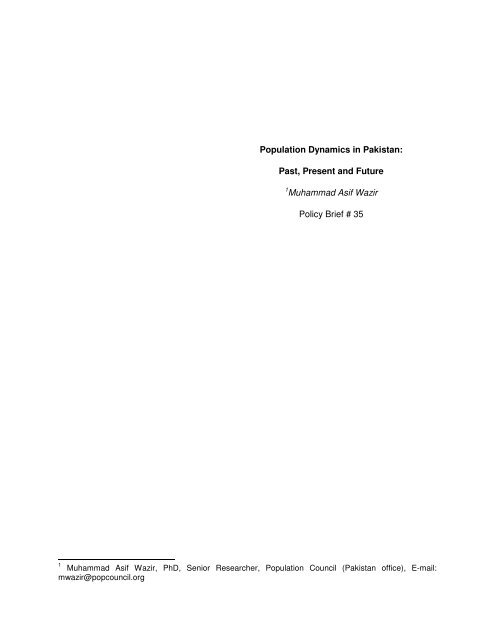
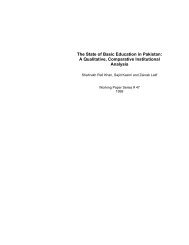
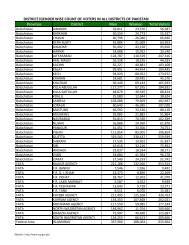
![(October - December, 2010) [13th SDC Special Bulletin]](https://img.yumpu.com/50118608/1/184x260/october-december-2010-13th-sdc-special-bulletin.jpg?quality=85)
